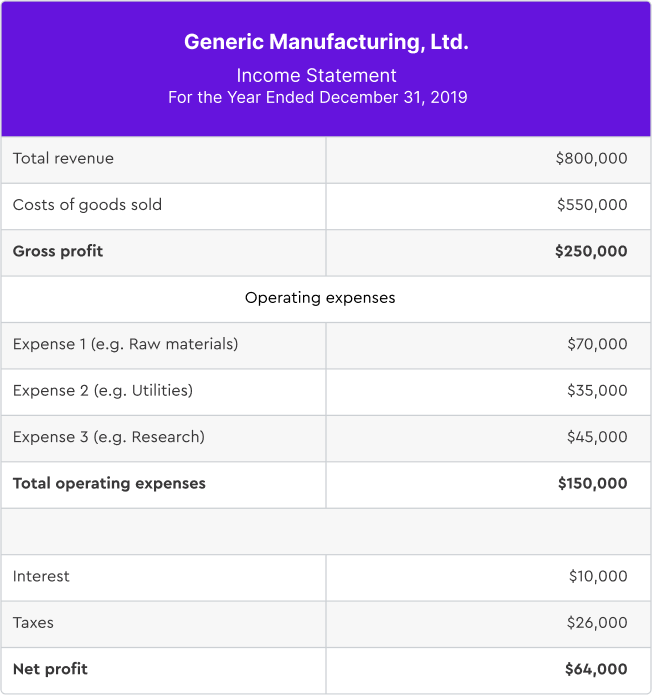
What Is the Formula for Calculating Profit Margins?
Is your business in the black?
That might sound a little ominous in other contexts, but when we’re speaking about profit margin, believe us when we say you definitely want to answer ‘yes’ to that question.
Being ‘in the black’ means that your business is earning more money than it’s spending – or earning a profit. But how do you measure your profit margin ratio? And what is a profit margin as opposed to profit?
Learn everything you need to know about profit margin below!
What is the profit margin formula?

Profit margin is a measurement that business owners use to determine how much money their company is earning per sale. As opposed to gross profit or net profit which are measured as an absolute dollar amount, the profit margin shows profits as a percentage of revenues. Regardless of whichever specific profit margin formula you’re looking at (we get to that below), you’ll always divide income by revenues.
Example: A manufacturing company sells $600,000 worth of products, and the total expenses (labor, marketing, rent, raw materials, interest, taxes, etc.) equal $400,000. Subtract the total expenses ($400,000) from the net sales ($600,000) and you’ll find the net profits equal $200,000.
To calculate profit margin, you’d then divide the net profits ($200,000) by the net sales ($600,000), which would equal 33% for this example. That means for every $1 made in revenue, $0.33 is profit and $0.67 is used to pay expenses.
You may be wondering why it’s important to know your business’s profit margin ratio as a percentage. Isn’t it enough to know how much profit you’re earning in terms of dollars and cents?
To put it plainly, the reason you should take close notice of your profit margin as a percentage is that your profit margin ratio may change as your sales rise or drop, while your net profits may simultaneously remain the same.
We’ll continue with the example above to explain further:
The manufacturing company is able to increase its net sales to $800,000. But, in order to do that, they had to invest in hiring more workers, expanding on their marketing strategy, renting more space, and so on.
Those changes raised the total expenses to $600,000. With these new values, the net profits will remain $200,000, but the profit margin will have dropped from 33% to 25%. That means for every $1 made in revenue, $0.25 is profit and $0.75 is used to pay expenses.
As you can see, increased revenue (net sales) doesn’t always mean increased profitability. That’s why it’s important to keep an eye on your business’s profit margins.
There are several variations of the profit margin formula that you’ll use in succession, each of which provides a slightly different perspective on your business’s performance. It’s important to learn the differences between the different profit margin formulas so you can have the broadest and deepest understanding of your business’s financial health.
Let’s get straight to it.
1. Gross profit margin

Gross profit margin measures how effectively your business is handling the direct costs of sales. This is the most general (and simplest) way to calculate profit margin, as it takes into consideration only the net sales and cost of goods sold (COGS).
Although it provides somewhat limited insight, measuring the gross profit margin ratio does allow businesses to see how well they’re performing in comparison to their competition.
If other companies are able to provide the same service or product as you and maintain a higher gross profit margin ratio, it means they’re either selling at a higher price or they’re producing at a lower cost than your business. In other words, a higher gross profit margin ratio means more money retained for every dollar of revenue and less money put towards expenses.
On the contrary, a lower gross profit margin means the direct costs of production are too high, your sales are too low, your pricing strategy can use some improvement, etc. – in any case, it means that your business plan is limiting your profitability and there are changes that need to be made.
You can use your gross profit margin to see how you compare to the industry standard and to your main competitors so that you’ll gain a better sense of where you stand.
2. Operating profit margin

The operating profit margin formula is slightly different and a bit more complex than the gross profit margin formula. Operating profit margin is calculated by subtracting all operating expenses (as opposed to only COGS) from the revenue, then dividing by revenue. Multiplying the resulting value by 100 lets us see that amount as a percentage.
By taking into consideration the indirect costs of operating the business (research, marketing, administrative expenses, etc.), this profit margin formula shows business owners how well those secondary investments are paying off. Remember, gross profit margin only measures your business’s ability to handle the direct costs of sales in relation to revenue.
Operating profit margin is also known as earnings before interest and taxes (EBIT) since this formula takes into account all expenses besides interest and taxes. This profit margin formula also gives business owners a clearer understanding of how much money they have available to pay debts, shareholders, and taxes.
Important: It is possible that your gross profit margin can be high while your operating profit margin is low. That would be an indicator that your business is spending too much on things like research and marketing, and you should reassess how much you’re investing in those areas.
3. Net profit margin

The net profit margin formula is the final metric in this succession of profit margin formulas; it includes all expenses involved in running the business including direct costs of sales, indirect costs of sales, as well as taxes and interest.
In other words, the net profit margin formula measures the relationship between net profits and net sales. This is what people are typically referring to when they ask about the profit margin ratio, which is why it’s the first profit margin formula that we mentioned.
Business owners can use the net profit margin formula to measure how effectively they handle the costs associated with their interest payments and taxes in relation to their revenue. If your gross and operating profit margins are relatively high, but your net profit margin is low, it means your business needs to either increase sales or decrease expenses.
Note: If your goal is to determine whether or not you’re earning enough money to pay off your debt, then take some time to learn about the debt service coverage ratio (DSCR).
How to calculate your profit margin using excel
If you’re unfamiliar with the process, measuring your profit margin ratio may come off as a daunting task. Don’t worry, you won’t have to take night courses at your local community college to figure it out – we’ve developed this quick & easy profit margin calculator for you to use…
Simply open the calculator and then download or save a copy so that you can edit the numbers that reflect your business. Click here:
Click that link so you can follow our manufacturing company example we include in the profit margin calculator.
Let’s imagine we’re looking at the income statement of a manufacturing business by the name of Generic Manufacturing Ltd. It looks like this:

Generic Manufacturing brings in $800,000 in revenue, spends $550,000 on the COGS, invests $150,000 on operating expenses, $10,000 on interest, and $26,000 on taxes.
With those values, we can calculate the gross profit margin, operating profit margin, and net profit margin:
GPM = ($800,000 – $550,000) / ($800,000) x 100 = 31.25%
OPM = ($800,000 – $550,000 – $150,000) / ($800,000) x 100 = 12.5%
NPM = ($800,000 – $550,000 – $150,000 – $10,000 – $26,000) / ($800,000) x 100 = 8%
What is the profit margin formula used for?
The profit margin formulas discussed here reveal lots of different information about a business’s financial health, stability, and viability. Some of the insights to be gained from looking into the profit margin include:
- Existing problems in the business plan. There are numerous reasons why your profit margin may be less than impressive. It could mean your cost of production is too high, your sales volume is too low, you need to come up with a better pricing strategy, your accounting department is making errors, etc.
- Avenues to reach higher profitability. Since the three different profit margin formulas focus on different types of expenses that your business has (COGS, indirect operating expenses, taxes & interest), you can use the differences between those profit margin ratios to see where your return on investments are paying off the most.
That will help you place your focus on areas of your business that are having the most positive impact; profit margin lets you prioritize your time and energy more effectively (similarly to how our LendingScore™ Dashboard help business owners focus on the highest priority factors impacting their ability to get funded).
- Necessary information when applying for business loans. There is a wide array of factors that lenders will take into consideration when looking at your business loan application, including your net profit margin. As you’ve already learned, having enormous revenues doesn’t mean much if your expenses are costing you too much – so it makes sense that loan providers will want to know your profitability and not just your net income.
When lenders look at your net profit margin over an extended period, it’ll serve as an indicator of how viable your business is and how reliable of a borrower you are.
Why is it important to measure profitability?
With the several uses of profit margin in mind, it’s easy to understand just how important it is to measure profitability with the help of the profit margin ratio. If you were to assess your business’s profitability with just your gross or net profit, you’d be stuck scratching your head trying to figure out exactly how to get profits to increase.
In order to pinpoint where your business needs improvement, there are different ‘levels’ of expenses that you should consider separately. Measuring profitability with the different profit margin formulas allows you to do just that.
Above and beyond easing your own efforts to improve your business’s finances from within, measuring your profitability will give you the information you’ll need to qualify for an injection of capital. Keeping your eye on profit margins at all times means you won’t be scrambling to gather the numbers when you do go looking for business funding, whether through alternative funding options or traditional bank loans.
What is considered a good profit margin?
Asking “what is a good profit margin?” is too vague a question to get any truly valuable answer. Asking what a good profit margin is in a particular industry is a better way to go since they vary so greatly from industry to the next.
For your convenience, we’ve narrowed down the list of average net profit margins by industry gathered by NYU Stern:
|
Industry |
Net Profit Margin |
|
Retail (general) |
1.9% |
|
Real Estate (general) |
41.23% |
|
Manufacturing (machinery) |
7.74% |
|
Home Construction |
7.19% |
|
Restaurants |
12.11% |
|
Trucking |
7.82% |
|
Information Services |
18.41% |
|
Auto & Truck |
1.82% |
Note: It’s not just net profit margins that vary from industry to industry – for business owners in search of funding solutions, it’s important to consider the different industry loans specifically tailored to their needs.
How to improve your profit margin
Top 3 ways to improve your profit margin:
- Reduce expenses
- Increase sales
- Raise pricing
- Bonus: Use BeProfit – Profit Tracker
1. Reduce expenses
Since each variation of the profit margin formula assesses the relationship between certain expenses and revenue, it only makes sense that cutting down on expenses will raise your profit margin. Plainly put, fewer costs mean more money retained per dollar earned in sales. Consider reducing the number of employees, finding suppliers with better rates, or developing more cost-effective ways of producing your goods or offering your services.
2. Increase sales
If you’ve reviewed your expenses and you need a second way to improve your profit margin, try increasing the volume of sales. How? Use different marketing strategies (such as social media marketing), improve your customer experience, find ways to develop a more attractive small business brand. You can also direct your operating income towards more research and development so you can start offering a more diverse array of products and services which ideally bring in more customers.
3. Raise pricing
Your efforts to boost your profit margin by reducing expenses and increasing sales made a difference, but not quite as much as you’d have liked. The next step: raise the prices on your products or services. It might drive a number of customers away, but if you go about it carefully, you’ll be able to retain enough customers (and keep bringing it more) despite the fact that they’re paying more than they used to.
4. Bonus: Use BeProfit – Profit Tracker
If you run a Shopify store, the BeProfit – Profit Tracker app is simply one of the best tools you can use to improve your online business’s profits. Making sense of all of your store’s data can get to be difficult, especially when you’re already spending lots of time running day-to-day tasks. With BeProfit you’ll understand your data in an easy-to-digest dashboard that tracks and analyzes your business’s profits, expenses, and more – so that you can help your online business become more profitable.
Final thoughts
There you have it! You now know what the profit margin formula is, what it’s used for, and why it’s important to know.
So, are you in the black?
If you’re still uncertain, scroll back up and use the Profit Margin Calculator that we’ve developed to help you out. Measuring your profit margin ratio will give you a variety of useful insights into your business’s profitability, so don’t stop yourself from earning more money!




